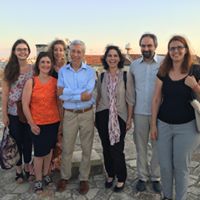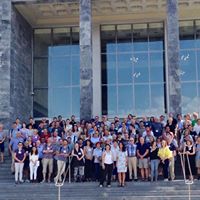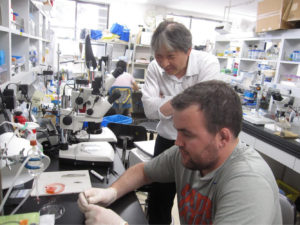The Pitt lab would like to welcome Amy Dorward to the group. Amy starts her 3 year BHF funded PhD studentship today. Amy will be looking at how zinc shapes calcium dynamics in ischaemic heart failure.
BHF highlights the importance of our work in the 2017 Annual Report Scotland
The Pitt lab would like to thank the BHF for highlighting our work as “breaking new ground” in the fight against heart disease in the 2017 annual report Scotland. We are grateful to the BHF for their continued support of our research.
Skeletal mineralisation “Hypotheses” article – accepted by FASEB J
Matrix mineralization is the process by which the skeleton forms and is maintained. Matrix vesicles (MVs) released from osteoblasts and chondrocytes serve to accumulate calcium and inorganic phosphate such that mineralization can take place. In a paper to be published in the FASEB Journal, the Stewart group (in collaboration with Prof Colin Farquharson, University of Edinburgh) propose the potential involvement of two enzymes, phospholipase A2 (PLA2) and ectonucleotide pyrophophatase/phosphodiesterase 6 (ENPP6), which may act together to generate inorganic phosphate from phosphatidylcholine in the MV membrane. Together they could produce phosphocholine, which in turn is a substrate for PHOSPHO1, an enzyme known to be essential for mineralization. The presented concept is backed up by various pieces of evidence; for example, both enzymes are expressed in mineralizing cells and it is known that phosphatidylcholine is broken down in MVs during mineralization. The paper, which will feature in a forthcoming issue, stemmed from a BSc(Hons) project that was researched by final year student, Darren Leong earlier this year.
China Visit
Alan Stewart was recently in Xining, Qinghai Province, China, where he delivered seminars in two Chinese Academy of Sciences (CAS) Institutes. These included the North West Institute of Plateau Biology, where he was bestowed the honorary position of Guest Professor. This is in part due to a new collaborative award of ¥400,000 from CAS to Dr Ruitao Yu, an Associate Professor at the Institute and former Visiting Scholar in the Stewart Group. During this new project, Dr Yu will spend another 3 months in Dr Stewart’s lab to examine the serum albumin binding characteristics of medicinally relevant natural products. Also whilst in Xining, Dr Stewart delivered a Keynote Lecture at a High-End Forum focussed on medicinally-relevant natural products and their usefulness for treatment of cardiovascular disease. Dr Stewart’s trip to China was funded by the Administration of Foreign Experts of Qinghai Province.
Leverhulme Trust Grant Award
The Leverhulme Trust have awarded a grant of £342,867 to Dr Claudia Blindauer, Dr Hugo van den Berg (both University of Warwick) and Dr Alan Stewart for a project entitled “A qualitative framework linking extracellular zinc speciation and cell uptake”.
Zinc is an essential micronutrient that participates in almost every major biological process. The health and wellbeing of humans and other mammals depends on well-regulated distribution of zinc among the tissues of the body. However, how this regulation is achieved is not fully understood. This new project will explore the hypothesis that uptake of zinc into cells is actively controlled by the zinc-binding capacity of major zinc-binding proteins in blood plasma. This will be achieved by combining biological, chemical, and mathematical methods. This exciting new project will provide crucial new information on an overlooked component of mammalian zinc homeostasis.
Zinc and sarcoplasmic calcium leak – Paper accepted in JBC
The paper is out!!! Many thanks to the BHF for supporting this work
Dysregulated Zn2+ homeostasis impairs cardiac type-2 ryanodine receptor and mitsugumin 23 functions, leading to sarcoplasmic reticulum Ca2+ leakage
Abstract
Aberrant Zn2+-homeostasis is associated with dysregulated intracellular Ca2+ release resulting in chronic heart failure. In the failing heart, a small population of cardiac ryanodine receptors (RyR2) display sub-conductance state gating leading to Ca2+ leakage from sarcoplasmic reticulum (SR) stores, which impairs cardiac contractility. Previous evidence suggests contribution of RyR2-independent Ca2+ leakage through an uncharacterized mechanism. We sought to examine the role of Zn2+ in shaping intracellular Ca2+ release in cardiac muscle. Cardiac SR vesicles prepared from sheep or mouse ventricular tissue were incorporated into phospholipid bilayers under voltage-clamp conditions, and the direct action of Zn2+ on RyR2 channel function was examined. Under diastolic conditions, the addition of pathophysiological concentrations of Zn2+ (≥2nM) caused dysregulated RyR2-channel openings. Our data also revealed that RyR2 channels are not the only SR Ca2+-permeable channels regulated by Zn2+. Elevating the cytosolic Zn2+ concentration to 1 nM increased the activity of the transmembrane protein mitsugumin 23 (MG23). The current amplitude of the MG23 full-open state was consistent with that previously reported for RyR2 sub-conductance gating, suggesting that in heart failure in which Zn2+ levels are elevated, RyR2 channels do not gate in a sub-conductance state, but rather MG23 gating becomes more apparent. We also show that in H9C2 cells exposed to ischemic conditions, intracellular Zn2+ levels are elevated, coinciding with increased MG23 expression. In conclusion, these data suggest that dysregulated Zn2+ homeostasis alters the function of both RyR2 and MG23 and that both ion channels play a key role in diastolic SR Ca2+ leakage.
Here is a link to the paper
http://www.jbc.org/content/early/2017/06/19/jbc.M117.781708.full.pdf?with-ds=yes
European Society of Cardiology Basic Science Summer School in Nice
In June, Amélie Sobczak, PhD student with Dr Alan Stewart, attended the Basic Science Summer School in Nice organised by the European Society of Cardiology. This 5-day event was attended by around 70 PhD and MD/PhD students working in cardiovascular research and consisted of a series of lectures and discussions on the latest advances and challenges in the field as well as workshops on outreach, publishing and career building. During the meeting she presented a poster relating to her research on the regulation of coagulation by zinc, work supported by funding from BHF. She would like to thank the organisers, Jeremy Pearson, Peter Ferdinandy and Yasmine Carrasset. She would also like to thank the School of Medicine and CAPOD for funding to support this visit.
International Society for Zinc Biology
The 2017 ISZB meeting took place in Pyla, Cyprus 18th-22nd June in collaboration with Zinc-NET. Dr Samantha Pitt would like to thank the organisers Nicola Lowe, Kathryn Taylor, Belma Turan and Michal Hershfinkel for putting together such an exciting programme. Samantha Pitt gave a talk entitiled “Dysregulated zinc may lead to ‘leaky’ calcium channels in heart failure”
Local politicians visit the Metal Ions in Medicine Group
 On the 24th March three local MPs/MSPs, Roger Mullin (SNP), Willie Rennie (Scottish Lib Dems) and Alex Rowley (Labour), together with representatives from the British Heart Foundation were in St Andrews to hear about the cutting-edge cardiovascular research being carried out in the School of Medicine. Dr Alan Stewart and Dr Sam Pitt as well as other researchers from the Metal Ions in Medicine Group (Dr Siavash Khazaipoul, Amelie Sobczak and Gavin Robertson) presented updates on their work. In addition, Prof David Crossman and Dr Simon Powis were in attendance, with Prof Crossman providing an introduction to the school and an overview of how biomedical research is funded and its importance to Scotland.
On the 24th March three local MPs/MSPs, Roger Mullin (SNP), Willie Rennie (Scottish Lib Dems) and Alex Rowley (Labour), together with representatives from the British Heart Foundation were in St Andrews to hear about the cutting-edge cardiovascular research being carried out in the School of Medicine. Dr Alan Stewart and Dr Sam Pitt as well as other researchers from the Metal Ions in Medicine Group (Dr Siavash Khazaipoul, Amelie Sobczak and Gavin Robertson) presented updates on their work. In addition, Prof David Crossman and Dr Simon Powis were in attendance, with Prof Crossman providing an introduction to the school and an overview of how biomedical research is funded and its importance to Scotland.





